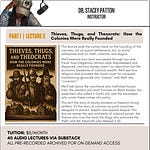In this harrowing descent into the belly of empire, we step inside the cargo hold, the beating heart of racial capitalism and the birthplace of whiteness. This is not the plantation. This is the blueprint. The laboratory. The furnace where human lives were transformed into capital, where wombs were monetized, and where childhoods were shackled before they could begin.
This lecture dismantles the sanitized textbook version of the transatlantic slave trade and exposes it for what it truly was: a multinational, corporatized, state-sponsored system of human trafficking that built the modern world. From the Zong massacre to the rape economy, from the selling of Black children to the invention of whiteness as a caste and currency, this lecture traces how Europe’s centuries-old child cruelty was racialized, scaled, and optimized for profit.
We map the financial ecosystem that made this horror sustainable, from insurance policies written on dead bodies to banks built on the backs of unborn Black children. We follow the trail of blood money into Ivy League endowments, Wall Street fortunes, and the ledgers of companies still in operation today.
But beyond the economics, this is a spiritual excavation. It is about the rupture, the tearing apart of kinship, culture, memory, and self. It’s about the transformation of people into property and the moral contortions required to justify it. It’s about how whiteness was forged as armor, but became a cage.
If last week exposed the empire’s foundation, this week exposes its soul. Prepare to descend into the hold, into the ledger, into the delusion that still shapes our world.
Core Conceptual Questions To Consider
What does it mean to say that the transatlantic slave trade was not a byproduct of empire, but the business model itself?
How did the slave ship function as a prototype for modern systems of incarceration, finance, and surveillance?
What does the commodification of the Black body in the cargo hold reveal about the foundations of capitalism?
In what ways was whiteness invented as a tool to protect and justify racial capitalism, not just culturally, but economically and legally?
How did banks, insurance firms, and governments institutionalize and normalize the violence of the slave trade?
What parallels can we draw between the financial instruments used to insure slave ships and today’s economic systems (e.g., mortgages, risk management, venture capital)?
What role did the U.S. domestic “breeding economy” play after the international slave trade was outlawed, and how did it shape the American South’s economy?
What was whiteness before the transatlantic slave trade and how was it constructed in its aftermath?
Why is it important to understand whiteness not as a static identity, but as a constantly shifting political technology?
How did the invention of whiteness offer poor Europeans power, status, and belonging even when they didn’t have land, wealth, or education?
Why were enslaved children such a central part of the transatlantic and domestic slave trade, and how were they “seasoned” into slavery?
How did Europe’s prior treatment of its own white children lay the groundwork for the racialized abuse of Black children in the Americas?
What are the long-term consequences—psychological, cultural, and genealogical—of trafficking and breaking children in this way?
Why do so few historical narratives center the spiritual, emotional, and existential rupture experienced by enslaved people in the hold?
What is the danger of treating slavery as merely “economic history” without naming its genocidal, reproductive, and psychological dimensions?
How does resistance show up in the stories of enslaved women, children, and even the smallest daily acts aboard the ships and plantations?
Why is it politically useful for textbooks and mainstream history to depoliticize and sanitize the transatlantic slave trade? Who benefits from that erasure?
What aspects of racial capitalism created in the cargo hold still structure our present-day society (e.g., policing, labor exploitation, healthcare disparities)?
What does it mean to say that “we’re still living in the compound interest of racial capitalism”?
If whiteness was forged to protect a lie, what would it mean—for individuals and society—to unmake it? What might freedom look like beyond whiteness?
Foundational Texts on Slavery, Capitalism & Empire
Sven Beckert – Empire of Cotton: A Global History
Traces how slavery and plantation labor built global capitalism, especially through cotton production.Walter Johnson – River of Dark Dreams: Slavery and Empire in the Cotton Kingdom
A brutal and detailed account of the slave economy in the Mississippi Valley, linking river trade, racial capitalism, and global markets.Edward E. Baptist – The Half Has Never Been Told: Slavery and the Making of American Capitalism
A deeply researched narrative that uses survivors’ testimonies and economic analysis to show how slavery built the U.S. economy.Stephanie E. Smallwood – Saltwater Slavery: A Middle Passage from Africa to American Diaspora
Focuses on the terror and erasure of the Middle Passage, treating the slave ship as a site of unmaking and commodification.Saidiya Hartman – Lose Your Mother: A Journey Along the Atlantic Slave Route
Blends memoir and archival excavation to explore the psychic and historical aftershocks of the slave trade.
Finance, Insurance, and the Slave Trade
Robin Blackburn – The American Crucible: Slavery, Emancipation and Human Rights
Includes sharp economic analysis of how European empires profited from slavery and how they rebranded themselves after abolition.Caitlin Rosenthal – Accounting for Slavery: Masters and Management
Explores how enslavers used early data management tools—spreadsheets, ledgers, and proto-accounting—to systematize and scale violence.Nicholas Radburn – Traders in Men: Merchants and the Transformation of the Transatlantic Slave Trade
A newer, essential read on how professional merchant networks and maritime finance operated trafficking as a transnational business.
Whiteness, Race, and Political Identity
Theodore W. Allen – The Invention of the White Race (Vols. 1 & 2)
A dense but vital investigation of how “whiteness” was socially engineered in colonial Virginia to divide laboring classes.David Roediger – The Wages of Whiteness: Race and the Making of the American Working Class
Explores how whiteness became a form of compensation for poor European workers in the U.S.Cheryl Harris – Whiteness as Property (Harvard Law Review article, 1993)
A landmark legal argument framing whiteness as a form of property and protected asset in American law.
Childhood, Reproduction, and the Economy of Enslavement
Wilma King – Stolen Childhood: Slave Youth in Nineteenth-Century America
Documents how enslaved children were sold, exploited, and psychologically broken into labor.Jennifer L. Morgan – Laboring Women: Reproduction and Gender in New World Slavery
Investigates the racialized commodification of Black women’s bodies through the logic of reproductive labor.Daina Ramey Berry – The Price for Their Pound of Flesh
Explores how every stage of Black life—from birth to death—was monetized under slavery.
Powerful Essays & Shorter Readings
Saidiya Hartman – “The Belly of the World: A Note on Black Women’s Labors”
(From Souls journal, 2016) — A searing piece on reproductive violence and the ongoing legacy of enslaved labor.Katherine McKittrick – “Plantation Futures”
(From Small Axe journal, 2013) — A brilliant theoretical framing of how plantations structure racial space and time.Toni Morrison – Beloved (Fiction)
A devastating novel that captures the legacy of slavery’s psychi
Listen to this episode with a 7-day free trial
Subscribe to Dr Stacey Patton to listen to this post and get 7 days of free access to the full post archives.









